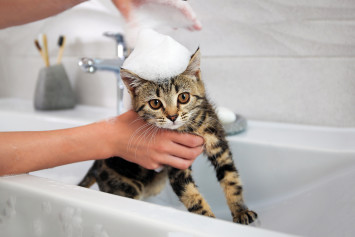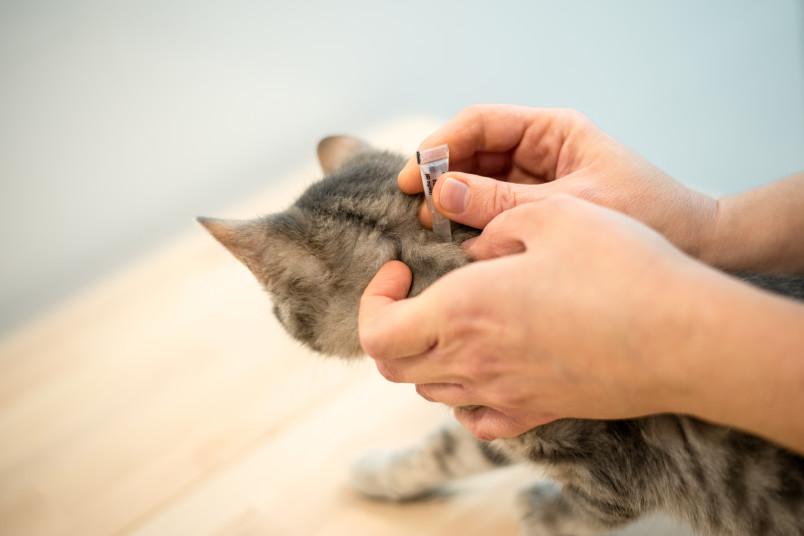
You’re finally bringing home your adorable kitten! Those big, curious eyes and playful swats at dangling toys fill your heart with joy. But you notice something troubling. Scratch, scratch, scratch goes your tiny furball, leaving behind irritated patches of skin. Fleas! The realization hit you – your precious kitten isn't just itchy.
Fleas are parasitic bugs that require a host to survive, and unfortunately, your kitten is their new home. These pests cause intense itching and discomfort, and in severe cases, can even lead to anemia.
In this article, we will discuss different options for flea treatment for kittens. You’re going to want to understand how to get rid of fleas on kittens so you can start helping your kitten feel better sooner!
Checking for Fleas on Kittens
You can check for fleas on kittens by running your fingers through their fur or using a flea comb. You may see live fleas, which appear as small, fast-moving, dark brown bugs darting through the fur. Even if you don’t see live fleas, seeing flea dirt also means your kitten has a flea problem and needs treatment. Flea dirt looks like small, black specks of dirt at the base of the fur.
When checking for fleas, be sure to check everywhere on your kitten’s body. Fleas particularly like to congregate around their face, belly, armpits, and at the base of the tail.
Tips for Safe Flea Treatments for Kittens
Fleas are pesky little bugs that can turn into a big problem quickly, so it’s important to start getting rid of them by treating all the animals in the house and managing the environment by vacuuming daily and washing all bedding.
Tip #1: Do Not Use Products with Permethrin or Essential Oils
Cats and kittens have unique systems and often have difficulty processing certain drugs and chemicals, even ones that are safe for dogs and humans. Permethrin is an insecticide that is regularly used in flea products for dogs since it works well, but it is incredibly toxic to cats. While most permethrin-based products have clear warnings on the packaging, be sure to check the ingredients of any product.
Unlike humans and dogs, cats and kittens lack the enzymes needed to process certain compounds found in essential oils as well. Even in low doses or concentrations, essential oils can be toxic to cats and kittens. So, while some internet searches might recommend essential oil-based remedies, we strongly advise against them.
Tip #2: Use Flea Treatments
That Are Approved for Kittens Most flea treatment products are only recommended for kittens who are either 8 weeks or older or over 1.5 pounds. Flea products aren't often tested on very young, very small kittens, and there is a risk of the concentration of the product being too high and causing adverse effects.
When looking for a flea treatment product, be sure to read the entire packaging label to make sure it’s safe for your kitten. You can also call your veterinarian, and they’ll be able to give you recommendations based on your kitten’s age and weight.
Tip #3: Use Natural Methods to Get Rid of Fleas on Very Young Kittens
Since most flea treatment products aren’t usually safe for kittens under 8 weeks old, you may need to use natural methods. These methods will only get rid of the adult living fleas on your kitten though. Since the flea life cycle can be as long as one year in some situations, these methods won’t prevent new fleas from hatching and living in the environment or on pets in the house.
Using a flea comb at least once per day can remove all living fleas without exposing your kitten to any products.
Bathing your kitten can also help get rid of fleas but use a shampoo that is safe for young kittens. Here are some other tips to consider when bathing your kitten:
Don’t use flea shampoo on kittens less than 12 weeks old.
Use a tear-free, gentle baby shampoo or Dawn dish soap
Don’t bathe your kitten more than twice per week
Be sure to keep your kitten warm during the bath and dry them quickly
Do Kittens Need Flea and Tick Prevention?
Flea and tick prevention is essential for both dogs and cats—even kittens! While fleas and ticks are a nuisance and can cause discomfort for your pet, they also lead to bigger problems like skin infections from itching, anemia, and even tick-borne diseases.
As we mentioned above, flea and tick products are only recommended for kittens 8 weeks or older. Once your kitten hits this age, you’ll be taking them to your veterinarian regularly for exams and to get their shots for kittens, so this is a good time to discuss flea and tick prevention with your vet.
The Power of Kitten Insurance
While this guide equips you to tackle fleas head-on, preventing them altogether is ideal. Consider enrolling in kitten insurance with an added wellness rewards program. These wellness plans often reimburse flea and tick preventative medications, helping you budget for crucial year-round protection. Plus, enrolling your kitten in pet insurance while they're young and healthy ensures they'll be covered for any future health concerns, including complications arising from flea infestations. Sometimes fleas can lead to bigger problems. Pet insurance may help cover costs associated with:
Skin infections: Constant scratching caused by fleas can lead to secondary bacterial infections requiring veterinary treatment.
Anemia: In severe cases, flea infestations can cause anemia, especially in young kittens. Embrace may help cover diagnostic tests and treatment for anemia.
Tapeworm infection: Fleas can act as intermediate hosts for tapeworms. Our plans may cover the diagnosis and treatment of tapeworms acquired from fleas.
By taking a proactive approach with both flea prevention and pet insurance, you can ensure a happy and healthy future for your playful kitten.

Recommended Flea and Tick Products for Kittens
There are many flea and tick products on the market for kittens but read the instructions carefully to make sure that it’s safe for your kittens’ age and weight. If your kitten is under 8 weeks old, ask your veterinarian for recommendations.
Revolution® is a popular brand with a “puppy and kitten up to 5 pounds” dose that can be used on kittens 8 weeks of age or older. However, this product isn’t over-the-counter and needs to be purchased directly from your veterinarian.
Frontline Plus® is an over-the-counter option that can be used on kittens 8 weeks or older and weighing over 1.5lbs.
PetArmor Plus® is another over-the-counter treatment option that can be used on kittens weighing 1.5lbs or over.
All the products above need to be applied once every month to be effective, but there are two more convenient options available once your kitten is older.
Seresto® Collars are a flea and tick product that can be used on kittens 10 weeks or older. These collars only need to be replaced every 8 months!
Bravecto® is another topical solution that can be used for kittens weighing 2.6 pounds or over, but it only needs to be reapplied every 12 weeks.
When you bring home a kitten, there are a lot of kitten costs to consider, and keeping them on a flea and tick prevention to remain parasite-free is one of those important costs.
How to Maintain a Flea-Free Environment
In addition to treating your kitten for fleas, you’ll also need to treat your environment too. Since fleas are so small and have such a long life cycle, they can hide in the smallest cracks and hatch at different times.
First, you’ll need to treat every pet inside the home with a flea treatment. Then, you’ll need to wash all bedding, rugs, and pet bedding in hot, soapy water. You’ll also need to vacuum the floors, making sure to get along the edges of the walls and up against furniture. Since fleas have a complex life cycle, it’s important to treat your pets and the environment at the same time to try to disrupt this life cycle. Ideally, you’ll need to continue vacuuming and sanitizing bedding daily for the next two weeks to continue picking up all remaining eggs and fleas.
From my own experience when I rescued a stray kitten with fleas, keeping up with the environmental cleaning was the hardest part, but the payoff of almost immediately seeing fewer fleas was worth it!
Keeping Your Kitten Flea-Free
If you notice even one flea on your kitten, you’ll want to act immediately. Fleas can reproduce and cause big problems quickly, so don’t let the issue fester. When choosing a flea treatment product for your kitten, it’s best to consult your veterinarian for a safe option, especially if you have a very young or very tiny kitten. The work doesn’t end once you treat your kitten, though. Be sure to vacuum, sanitize, and clean daily to make sure that your environment stays flea-free so that your kitten remains healthy and comfortable.
Hopefully you're well-equipped to tackle those pesky fleas and create a happy, healthy environment for your precious kitten. Remember, early intervention is key! By acting quickly and choosing a safe treatment method, you can provide your little furball with fast relief and prevent future infestations.
Don't hesitate to consult your veterinarian if you have any questions or concerns. They can provide personalized guidance based on your kitten's specific needs.
With a little patience and the right approach, you'll have your playful, itch-free kitten back to their energetic self in no time.